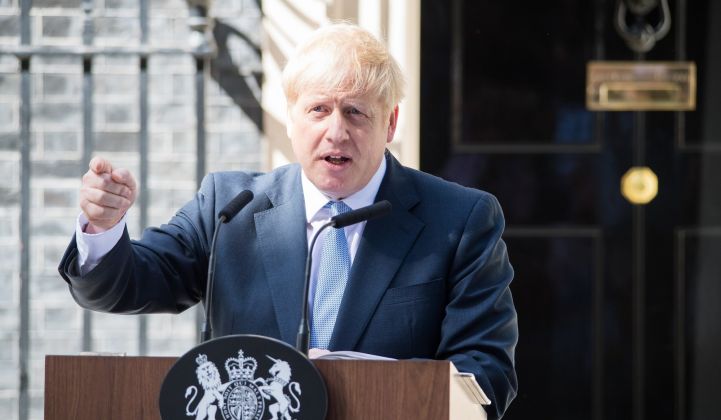The Conservative Party swept to victory in the U.K.’s general election, achieving a huge majority and breaking the country's political deadlock.
The current Brexit divorce deal is set to be approved as early as next week. After meeting the queen in Buckingham Palace on Friday, Prime Minister Boris Johnson's car will drop him back at Number 10 Downing Street, and his work will begin.
So what can we expect from his emboldened government on an energy front, and what challenges will the renewables sector have to navigate?
Net-zero is going nowhere
Johnson’s predecessor Theresa May squeezed through the 2050 net-zero target before she stepped down, in what was viewed as an attempt to add one achievement to a brief and challenging stint in power.
Johnson’s victory speech Friday morning included a recommitment to this goal and to the green industrial revolution that all but the furthest-right Brexit Party had been backing.
He said his party would deliver "colossal new investments in infrastructure [and] science, using our incredible technological advantages to make this country the cleanest, greenest on earth with the most far-reaching environmental program.”
"And you, the people of this country, voted to be carbon-neutral in this election. You voted to be carbon-neutral by 2050, and we will do it,” said Johnson.
The EU’s Green Deal, launched this week, seeks to match the U.K.’s goal. The challenge for both is now on implementation.
The U.K. hosts the U.N.’s COP26 climate negotiations in Glasgow at the end of 2020. Before those talks get underway, the Conservatives will be expected to provide more detail on how they will achieve that net-zero target. Trade body RenewableUK was quick to call on the new government to get to work.
“Rapid expansion of renewables, including low-cost onshore wind and innovative tidal energy, is key to decarbonizing our economy and will provide huge benefits for consumers and businesses across the U.K.,” the industry group said in a statement.
Planning scrutiny for offshore wind
The Conservatives have a strong record on offshore wind, having overseen the development of the country's market to a world-leading position. The government has backed offshore wind’s support via the contracts for difference mechanism, while at the same time removing a route to market for solar and issuing a planning moratorium for new onshore wind.
But while it has issued a 40-gigawatt target for offshore wind, planning could prove to be a challenge for the industry. The government has held up 4.5 gigawatts of offshore wind projects via the planning process.
Major infrastructure projects are subject to ministerial approval. For renewables, that means any project of 50 or more megawatts. Ørsted’s 2.4-gigawatt Hornsea 3, alongside Vattenfall’s 300-megawatt Thanet 2 extension and its 1.8-gigawatt Norfolk Vanguard project, have all been asked to produce reams of new submissions for their applications with concerns varying from shipping lanes to birds. In November the government also launched an investigation into the onshore infrastructure the projects will require.
Brexit is happening
With a majority of 78 (and only one seat of 650 left to declare), Johnson has the votes he needs to get his Brexit deal — a slightly amended version of the thrice-defeated deal that ended Theresa May’s premiership.
The deal in question sets out the terms of the U.K.’s departure. Many of the impacts from Brexit have been anticipated.
Interconnections to other countries are one issue for the power sector that garnered attention when the Brexit referendum result was first announced. The U.K. gets around 6 percent of its power from interconnections to the continent. As grids take on more variable generation, the capacity of interconnections is expected to double, making them even more important.
Research firm Baringa Energy Partners told GTM that the impact of Brexit on interconnectors has largely been mitigated. Even if the deal did not pass and instead the government chose to leave the EU with no deal, it is unlikely that punitive tariffs would be applied to electricity trading on those interconnectors.
Under a no-deal scenario, trading terms between the EU and U.K. would default to World Trade Organization rules, and those don’t apply any tariffs to electricity interconnections. U.K. tax authorities are understood to have told the companies running the infrastructure that they aren’t interested in applying tariffs on these power flows.
There is less clarity around how smooth such trading might be, however. System operator National Grid SO told GTM that if the U.K. were to leave the EU’s internal energy market (IEM), trading power could become less efficient, even in the absence of trade tariffs.
“We assume that [the government] is working hard to come to a decision on auctions arrangements that might try to replace some of the efficiencies lost from leaving the IEM. This will help to limit the efficiency loss on ‘day 1’ and move into an enduring solution,” a spokesperson said.
Things are more complicated on the island of Ireland, which currently has its own single energy market (SEM). Northern Ireland will not be in the EU but the Republic of Ireland will. The island relies on power flowing across the border unhindered.
“The biggest risk remaining is the future of the SEM in Ireland. [The department of Business, Energy and Industrial Strategy] notes that additional powers may be needed to preserve security of supply, and that they have developed legislation to kick in in the event of no-deal, and they realize that the SEM cannot legally continue to operate," the spokesperson said.




